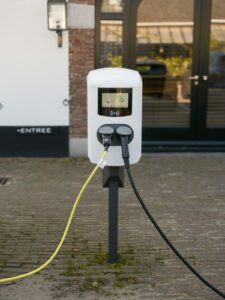
Home / EV Charging News / How to Decide Between a Hybrid and an EV?
Electric Vehicle (EV) technology is a revolutionary transport alternative that has enjoyed skyrocketing popularity in the last decade. This technology includes Plug-In Hybrid Electric Vehicles (PHEVs) or hybrid cars and Battery Electric Vehicles (BEVs) or pure electric cars, while both of them are considered EVs, they are quite different.

Figure 1: Hybrid car vs. electric car
If you want to learn more about hybrid cars and electric cars, their similarities, and differences, this article is for you. Here we dive into detail on the main aspects between electric cars vs hybrids, list the most important pros and cons for each one of these, and help you choose between hybrid or electric vehicles depending on what you are looking for.

Figure 2: Operation of PHEV vs. BEV
Both PHEVs and BEVs are designed to work using EV technology, where a high voltage Lithium-Ion battery powers one or more electric engines to transfer kinetic power to the wheels. There are important differences between electric cars vs hybrid cars, here we explain each option, detailing how they differ from one another.

Figure 3: Schematic of a Tesla Model S
BEVs or pure electric cars feature a high-capacity Lithium-Ion battery that stores electrical energy and powers the electric motor of the vehicle. This type of car does not require any gas to transfer power to the wheels and is entirely powered with electricity, featuring zero-tailpipe emissions.

Figure 4: Schematic of a Plug-In Hybrid Vehicle
On the other hand, a Plug-in EV (PHEV) or hybrid car, combines the technology of BEVs with that of Internal Combustion Engine (ICE) vehicles. These vehicles feature a much smaller Lithium-Ion battery that delivers an average driving range of 30 to 60 miles. The majority of the range for PHEVs comes from the combustion engine powered with regular gas, like ICE vehicles. The PHEV first consumes the available range in the battery and then they run on gas.
There are major important differences between hybrid cars vs electric cars. The most important one is that PHEVs heavily rely on the combustion engine to burn gas and send power to the wheels, barely relying on the electric engine for power. On the other hand, BEVs rely only on the electric motor powered with electricity.
Since PHEVs rely more on the combustion engine for driving longer distances, these vehicles generate more tailpipe emissions, they have short electric driving range, and they are relatively more expensive to drive on the long run than BEVs. BEVs on the other hand, are cheaper to drive in general, feature zero tailpipe emissions, and deliver a high electric driving range.
Since hybrid vehicles feature EV technology and ICE vehicle technology, they share the best of both worlds.
While PHEVs are excellent starter vehicles for those switching from ICE vehicles to EVs, not everything is perfect. Here we list some disadvantages of hybrid cars.
BEVs are a popular rising technology, in part due to their amazing advantages compared to ICE vehicles and PHEVs. Let’s analyze some of the advantages from pure electric cars.
While EVs have many positive factors, there are some disadvantages to this technology. Here we list the most important ones.
| Battery Electric Vehicle | Plug-In Hybrid Electric Vehicle | |
| Fuel source | Lithium-Ion battery | Lithium-ion battery and gas tank |
| Electric driving range | 200 – 500 miles | 30 – 60 miles |
| Recharge/refilling time | Several hours | A few minutes (gas tank only) |
| Upfront cost | High upfront cost | Moderate upfront cost |
| Tailpipe emissions | Zero tailpipe emissions | Burns gasoline for power when not using the electric engine |
| Overall CO2 emissions | Potential to reduce emissions by charging with clean energy | The combustion engine will always release CO2 |
| Driving cost | Low driving cost | Low driving cost (electric engine) & high driving cost (gas tank) |
| Incentives | Most EV incentives | Few EV incentives |
| Energy efficiency | High energy efficiency | Low energy efficiency with gas tank & high energy efficiency with electric engine |
Table 1: Comparing hybrid cars vs. electric cars
It is important to understand that separating electric vs hybrid car models and choosing which one is better, is not an easy task. Battery EVs can be the best option for some drivers, while hybrid cars are the most suitable car for others.
Pure electric cars are better for EV drivers looking to fully dive into the EV experience. These vehicles entirely rely on electric power from the battery, feature zero tailpipe emissions, highly reduce CO2 emissions, and use energy more efficiently. They also provide the complete EV driving experience, but they have the setbacks of the long charging time and the high upfront cost.
Plug-in hybrid cars are not so great for those looking for the full EV experience but are ideal for reliant ICE vehicle drivers that want to test the EV experience without fully diving into it. A PHEV is an excellent option if you want to drive with an electric engine, learn more about EV charging, and reduce your carbon footprint, without leaving entirely aside the ease of a gas tank.
$2,890.00 Original price was: $2,890.00.$2,790.00Current price is: $2,790.00.
$3,950.00 Original price was: $3,950.00.$3,450.00Current price is: $3,450.00.
$1,650.00 Original price was: $1,650.00.$1,590.00Current price is: $1,590.00.
$2,290.00 Original price was: $2,290.00.$2,150.00Current price is: $2,150.00.
$1,290.00 Original price was: $1,290.00.$799.00Current price is: $799.00.

Your Power Management Partner for Over 25 Years Future Generations Depend on Our Decisions Today ™
2024 © All rights reserved by CyberSwitching